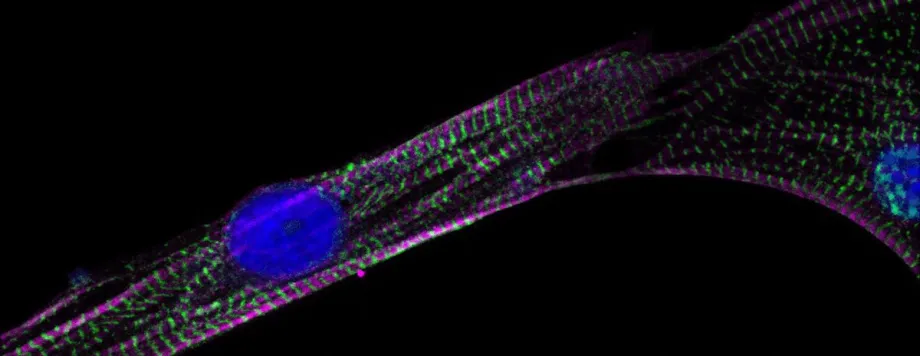
Joseph Wu lab: A sarcomere, or part of a cardiomyocyte that helps heart cells beat, retains its structure after treatment with indisulam and doxorubicin. (The blue dot is the nucleus of the cell.)
Stanford Medicine News Center - November 27, 2024 - by Caroline Hemphill
Using a gene-screening method they created, Stanford Medicine researchers may have discovered why an effective chemotherapy damages heart cells — and they have identified a drug that could keep the heart cells beating.
The chemotherapy, doxorubicin, kills cancer cells, but it also causes heart cells to beat out of rhythm, organize incorrectly or die. If used in high doses or for extended periods, the drug can lead to heart failure, limiting its use despite its effectiveness in treating cancer.
“We’ve always wanted to find a way to stave off this toxicity,” said Joseph Wu, MD, PhD, a professor of cardiovascular medicine and the director of the Stanford Cardiovascular Institute.
Wu and Stanley Qi, PhD, an associate professor in bioengineering and a scholar at Sarafan ChEM-H, created a genetic screening tool that harnesses CRISPR, a gene-editing technology, to uncover genes that may be involved in doxorubicin-induced heart damage. The screen pinpointed a gene that seemed to be one of the key vehicles through which doxorubicin inflicted damage.
“This CRISPR screen is a valid tool for drug discovery,” said Wu, the Simon H. Stertzer, MD, Professor. “That, to me, is the key take-home message of the study.”
Wu and Qi share the senior authorship of the paper, published in Cell Stem Cell Nov. 7, describing the research. Chun Liu, PhD, an assistant professor at the Medical College of Wisconsin and a former Stanford Medicine postdoctoral researcher, and Mengcheng Shen, PhD, a researcher and instructor at the institute, are the lead authors on the paper.
Genetic needle in a haystack
The researchers knew that doxorubicin caused harm to heart cells, but they didn’t know which genes were involved in the damage. They narrowed their search to 2,300 genes that existing drugs already target.
“Most of the time, when you do a drug screen, you know what the target gene is, and then you screen for drugs that block that gene,” Qi said. But in this case, Wu and Qi didn’t know the target gene, so they used a new genetic screening technique to observe the effects of doxorubicin on heart cells that were derived from induced pluripotent stem cells, which can give rise to any cell in the body.
The researchers used CRISPR to turn on or turn off one of the 2,300 genes in the heart cells such that each cell had only one gene changed. They then doused those cells with doxorubicin and noted which ones survived. The question then was, Why did they survive? To find out, the researchers sequenced the DNA of each cell, looking for genetic markers.
They found that the healthiest cells after doxorubicin treatment lacked a gene called CA12, which catalyzes reactions involving carbon dioxide to maintain a variety of the body’s functions, such as respiration and the formation of saliva. The researchers did more genetic tests, deleting CA12 from heart cells and confirming their suspicion: Cells without CA12 resisted doxorubicin-induced toxicity. The details of what the gene does during doxorubicin treatment are not yet clear, Wu said, but he hopes to figure that out.
Searching for a solution
Once Wu and his team pegged CA12 as a genetic factor in doxorubicin toxicity, they wanted to find a way to stop the CA12 protein from damaging heart cells. They picked 40 drugs that inhibit carbonic anhydrase proteins such as CA12. They gave the drugs, along with doxorubicin, to groups of heart cells that were not genetically edited. They compared the groups’ survival rate to find which cells stayed healthiest throughout the treatment.
A drug called indisulam, currently being studied as a potential cancer treatment, helped cardiomyocytes survive doxorubicin toxicity. Indisulam protected the heart cells’ ability to relax and contract and aided in maintaining cellular processes.
The next step was to test indisulam in a living organism. They treated mice with doxorubicin, then fed one of two groups indisulam. The mice that had indisulam along with the doxorubicin fared better, with stronger heart function and fewer signs of heart atrophy. Their heart cells also maintained their structure better.
The researchers are interested in how indisulam stops CA12 activity and plan to do more tests on the drug candidate to curb doxorubicin’s toxicity. They also hope to study how multiple genes interact in heart cell damage rather than focusing on one gene’s effect at a time.
The researchers likewise have big goals for their newly developed CRISPR screen, hoping to apply the technology beyond heart cell toxicity. “It’s a proof of principle,” Wu said. “In the future you could use it for other types of toxicity or diseases. We think it’s a very powerful tool.”
Researchers from the Medical College of Wisconsin, Greenstone Biosciences, the University of North Texas, and the City of Hope Comprehensive Cancer Center also contributed to the study.
The study was supported by the National Institutes of Health (grants R01 HL141371, R01 HL141851, R01 HL145676, R01 HL150693, R01 HL171102, R01 CA266470, R21 CA270609, P01 HL141851, K99/R00 K99HL166693 and K99HL166773), the American Heart Association, Chan Zuckerberg Biohub, the National Science Foundation and the California Institute of Regenerative Medicine. Stanford’s Cardiovascular Institute also supported the work.


